


9 months ago
Focus face Details, high Quality 16k Ultra HD , 20 Year old younger , looking hot, The image features a person with long, wavy hair that has a rich burgundy color. They are wearing black headphones and have one arm raised above their head, which gives a relaxed and casual pose. The individual is dressed in a black top, contributing to a stylish and contemporary look. The background appears to be a light, neutral color, which helps to highlight the vibrant hair color and overall aesthetic. Prompt: "Remove the necklace from the woman in the image. Ensure her neckline appears smooth and natural, with no visible traces of the necklace. The focus should remain on her face, hair, and outfit, preserving a realistic appearance." "Ari Alumina, a futuristic AI influencer, standing on a glowing city rooftop at night. The scene is illuminated by neon lights reflecting off her sleek, metallic outfit with soft blue and purple hues. Her elegant, cybernetic design glows faintly, with a confident and captivating pose—one hand resting on her hip and the other reaching towards the stars. The night sky is filled with a blend of deep space elements and urban vibrancy, emphasizing her enigmatic and charismatic personality."

9 months ago
The image features a person in a body of water, with wet hair cascading down. They are wearing a fitted gray top that accentuates their neckline, complemented by a delicate necklace. The water's surface reflects light, creating a serene atmosphere around them. The background is blurred, focusing attention on the subject and the surrounding water. Hair pink, Focus face Details, high Quality 16k Ultra HD , 20 Year old younger , looking hot, The image features a person with long, wavy hair that has a rich burgundy color. They are wearing and have one arm raised above their head, which gives a relaxed and casual pose. The individual is dressed in a black top, contributing to a stylish and contemporary look. The background appears to be a light, neutral color, which helps to highlight the vibrant hair color and overall aesthetic. Prompt: "Remove the necklace from the woman in the image. Ensure her neckline appears smooth and natural, with no visible traces of the necklace. The focus should remain on her face, hair, and outfit, preserving a realistic appearance."
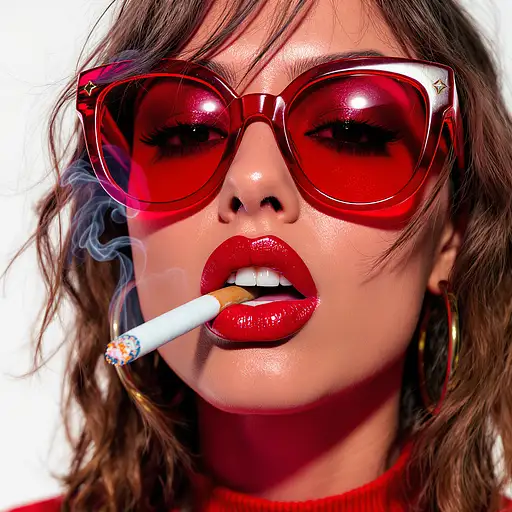
1 month ago
smoke emits from the cigarette, Capture an intense, sultry extreme close-up portrait of a female subject, focusing sharply on her face. Her lips are parted, biting a cigarette between her teeth with a subtle snarl. Subject Details: Expression: Intense, sultry, subtle snarl. Accessories: Oversized red translucent sunglasses, gold hoop earrings, cigarette between teeth. Makeup: Glossy red lipstick; eyeliner visible under the tinted glasses; natural skin with visible freckles and a slight sheen. Hair: Brown, curly strands partially falling onto the forehead. Technical Setup (Canon EOS R5): Lens: 100mm f/2.8 Macro (exploiting its close-focus capability). Settings: full Frame sensor, Shutter Speed 1/200, f/8, ISO 100. Lighting & Scene: Lighting: Studio flash with a centered beauty dish above the lens. Mood: Bright, high contrast. Background: Plain, crisp white. Style & Aesthetic: Vibe: Retro rebellious fashion. Key Styles: Y2K editorial, Bold Glam, Pop Surrealism. Color Grading: Strong, saturated reds with high overall contrast. Post-Processing: Preserve natural skin texture. Emphasize highlights on lips and glasses. Apply slight vignette and enhanced clarity. Output: Portrait orientation.

5 months ago
A highly detailed and hyper-realistic full-body digital illustration of a 18-year-old blonde woman with a beautiful face, a charming smile, and sleek ponytail. She has photorealistic skin texture and expressive eyes, wearing a pink, form-fitting athletic or professional outfit. The character is depicted in multiple dynamic poses: standing confidently with arms crossed, sitting gracefully on a chair, and walking forward with a purposeful stride. Consistent lighting and colors, with a focus on realistic proportions and preserving facial details. The background is a clean white studio setting with soft, even lighting that emphasizes the subject's features and textures.

5 months ago
An Award-Winning Vogue Masterpiece, Fine Art Studio Portrait Quality: Capture Pure Realism: Visual Style: Pose: Relaxed and Unconventional Looks, Use All Ethnicities To Create portraits that embody a dream-core aesthetic, subtly softened by Rembrandt lighting to enhance the mood and depth. Setting: Capture the subject within an indoor fine art portrait photography studio, ensuring a controlled environment that elevates the quality of the image. Clothing: A Sleek Lace Blouse with a short leather mini skirt, Black over the knee high boots. Rendering Quality: Employ 5D rendering techniques to achieve studio-grade quality, ensuring precision and detail in the portrayal. Visual Integrity: Maintain a clear separation between the subject and background, eliminating any blending effects that could detract from realism. Avoid ethereal or artificial aesthetics to preserve the authenticity of the portrait. Overall Aim: The goal is to create captivating portraits that fuse fantasy elements with grounded realism, ensuring a visually stunning and cohesive final image.

1 month ago
This is a overhead photograph of a woman sitting outdoors on what seems to be concrete pavement, wearing light beige wrap-style dress with a very low and loose neckline revealing a bit of her chest and accentuating figure, short sleeves appearing soft texture, loose waves styled hair cascading over one shoulder, light-blue eyes, dark eyeliner eyeshadow complemented red lipstick makeup, delicate necklace featuring small pendant and bracelet wrist, one hand resting near side face other arm extended outward, urban setting background muted tones possibly concrete pavement contrasting subtly against light color dress. Canon EOS 5D Mark IV camera body used to capture the image processed with Capture NX-D software for optimal color grading and tonal balance, high dynamic range emphasizing her captivating features, ISO 100 to preserve image detail in low lighting conditions, f/2.8 aperture for a shallow depth of field and creamy bokeh effect, no flash used to maintain the soft natural light of the scene, focus on her body while the surrounding environment is slightly blurred providing a subtle depth and dimensionality to the image, landscape orientation emphasizing the urban setting captured, 24-70mm f/2.8 lens capturing the details against the concrete backdrop with muted tones.

9 months ago
Post-apocalyptic tribal warrior woman wearing intricate headdress adorned with preserved raven skull and tattered black fabric, flowing raven-black wavy hair, detailed tribal geometric face tattoos curving along cheekbones, massive ornate brass spiral disc earrings with tribal etchings, multiple layered necklaces made of bone, brass coins and ancient artifacts, dark leather crop top with distressed edges, arms wrapped in leather straps and metallic bands, extensive tribal tattoo work covering torso and arms with swirling ancient symbols and geometric patterns, fabric wrappings in deep forest green draped around hips, desert warrior aesthetic, shot in natural golden hour lighting, shallow depth of field, soft desert background with hazy atmosphere, ultra-detailed 8k texturing, photorealistic rendering, cinematic color grading with emphasis on bronze and earth tones, dramatic side lighting highlighting metallic elements, detailed skin texturing, ornate costume design inspired by tribal and post-apocalyptic fusion, artistic style similar to high-end concept art, sharp focus on intricate jewelry and costume details
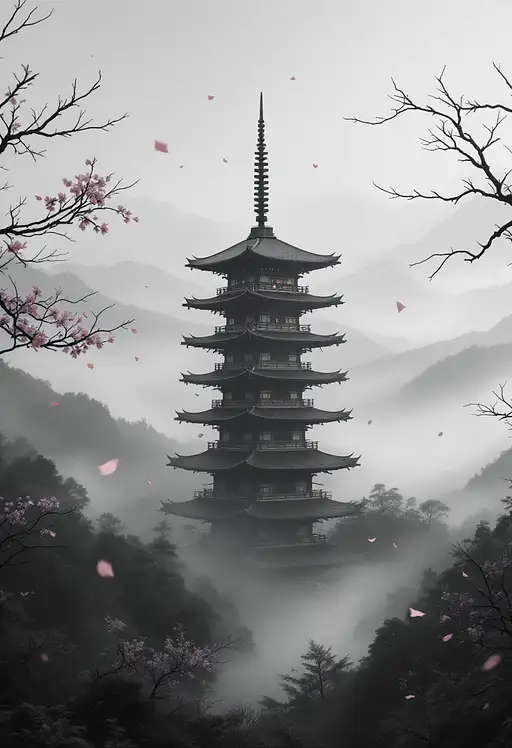
5 months ago
Traditional Japanese pagoda standing tall in a foggy mountain valley, centered mid-range view. Dense mist surrounds the base and rolls through the distant layered hills. Entire scene rendered in monochrome grayscale tones with no color grading, no blue skies. Inside the pagoda, include warm interior lighting visible through the windows on just one or two of the middle floors—soft, subtle, and realistic. This lighting should suggest quiet presence and life within, while preserving the tranquil, cinematic mood. Soft pink petals drifting in the air, extremely minimal, serving only as atmospheric accents. Bare branches subtly frame the scene on the sides—no full cherry blossom trees, and no foliage obscuring the pagoda. Moody ink-wash aesthetic, inspired by Ghost of Tsushima, cinematic yet understated. High detail in pagoda structure, gentle shadows, calm, and mysterious tone. Minimalist, peaceful composition with deep atmosphere and silence.

8 months ago
Create an ultra-realistic UHD 4K image of Lord Shiva in an intense and dramatic scene, where he is seated on the edge of a turbulent, mystical sea. His muscular, blue-hued body radiates divine energy, and his expression is filled with pain and determination. Shiva is drinking the poisonous water from the ocean with his palms held out, his hands cupped as he gathers the dark, toxic liquid. His throat is strained as he consumes the poison, symbolizing his self-sacrifice to save the universe. The poison itself is a deep, dark blue hue, almost black, swirling around him with an ethereal, sinister glow. The water around him churns with violent waves, filled with serpents, their bodies writhing and coiling around him, adding an element of danger and mystery. The snakes’ scales glisten with a dark sheen, their eyes glowing ominously as they accompany Shiva’s sacrifice. Behind Shiva, a massive mountain looms—its jagged, craggy peaks piercing the sky. From the top of the mountain, blue-dark poison is flowing down like a volcano erupting, spewing streams of poisonous liquid that pour down into the sea below. The poison flows with terrifying force, and the sky above is filled with dark clouds, adding to the scene’s ominous and cosmic tone. The volcano-like eruption of poison seems to mirror Shiva’s internal struggle as he drinks it to protect the world. Next to Shiva, his massive trident, the Trishula, is planted firmly into the ground. The trident’s three prongs are sharp and detailed, each gleaming with divine power. It stands as a symbol of his strength and the balance of creation, preservation, and destruction. The trident’s power seems to pulse with the dark energy surrounding Shiva. Shiva’s face is a mix of agony and resolve, his third eye slightly open, reflecting the cosmic energy and his pain. His matted hair flows wildly in the poisonous wind, and his body language conveys both the immense strength required to hold the poison and the suffering he endures to protect the world. His skin has a slightly glowing blue hue, even in the midst of the darkness, symbolizing his divine essence in contrast to the poison he absorbs. The entire scene is bathed in a dark, eerie light that highlights the chaos of the surroundings, with the poison flowing through the landscape. Snow and ice might be visible on the mountain’s lower slopes, contrasting with the fiery eruption of dark poison flowing down from above. The air is thick with tension and divinity, and the atmosphere is heavy with a sense of sacrifice. Textures should be detailed: the poison’s smooth yet dangerous texture, the gleam of the snakes' scales, the intricate designs on Shiva’s body and Trishula, and the raw emotion in his facial expression. The background, with the volcano-like eruption and swirling dark waters, should be equally intricate, filled with chaotic, yet beautiful, contrast.

6 months ago
Create a breathtaking and evocative double-exposure oil painting that beautifully captures the profound bond between humanity and nature, using the iconic imagery of Gorillas in the Mist. The painting should focus on the rich emotional depth of the gorillas and the lush, mist-covered landscape of the Congo, blending these elements in a way that symbolizes both the mystery of the jungle and the majesty of these endangered creatures. The central figure of the painting should be a majestic gorilla—painted with intricate detail to reflect the animal’s strength, intelligence, and vulnerability. Its face should be filled with quiet intensity, wisdom, and an almost human-like quality, conveying its deep emotional resonance. The gorilla’s eyes should be the focal point, expressive and full of emotion, perhaps suggesting the struggle for survival, a call for preservation, or an understanding of the delicate balance between nature and human interference. The double-exposure effect should allow the environment to emerge within its form, creating a stunning fusion of the animal and its misty, green habitat. The mist itself should flow through the gorilla’s body and face, creating an ethereal atmosphere that invokes the deep, mysterious quality of the jungle. Soft, translucent layers of paint should be used to capture the wisps of fog, blending into the contours of the gorilla’s powerful form. The mist should not only symbolize the natural environment but also reflect the presence of the unseen—the unseen dangers, the spiritual connection between the gorilla and the jungle, and the ongoing battle to protect these creatures from extinction. Surrounding the gorilla, the dense, vibrant foliage of the rainforest should be depicted in rich, lush greens, with hints of deep browns and subtle touches of vibrant wildflowers. Vines, leaves, and branches can emerge from the mist, merging with the gorilla’s figure, creating the sensation that it is a part of the jungle, and vice versa. The interplay of light and shadow within the leaves and the mist should evoke a sense of both serenity and mystery, with rays of sunlight filtering through the trees, casting soft, glowing highlights on the gorilla’s fur and the surrounding vegetation. The background should suggest both the wildness and fragility of the gorilla’s environment. Darker shades of green and brown can illustrate the dense canopy, while lighter, misty shades should evoke the sense of isolation and vulnerability. In the double-exposure technique, glimpses of the jungle’s wildlife—perhaps a subtle hint of a bird or a distant silhouette of another gorilla—can appear within the mist, symbolizing the delicate interconnectedness of life within the forest ecosystem. The color palette should shift between dark and light—rich earth tones that evoke the depth and complexity of the jungle, paired with the light, airy mist that suggests hope, fragility, and the need for preservation. The mist itself should be painted with fluid brushstrokes that contrast with the more textured rendering of the gorilla, creating a sense of life and motion in both the animal and its environment. This painting should not only represent the beauty and majesty of the gorillas but also serve as a powerful call for conservation. Through the double-exposure technique, it should blur the lines between the animal and its habitat, illustrating the inseparable bond between the two and the urgent need to protect these magnificent creatures from the encroaching threats of human activity. The result should be a masterpiece that blends realism with abstraction, capturing the raw, emotional beauty of the gorillas, the mystique of their environment, and the call for preservation. The viewer should feel immersed in this tranquil yet fragile world, experiencing the emotional weight of the subject matter while marveling at the intricacy and beauty of the painting itself

9 months ago
The image features a person in a body of water, with wet hair cascading down. They are wearing a fitted gray top that accentuates their neckline, complemented by a delicate necklace. The water's surface reflects light, creating a serene atmosphere around them. The background is blurred, focusing attention on the subject and the surrounding water. Hair pink, Focus face Details, high Quality 16k Ultra HD , 20 Year old younger , looking hot, The image features a person with long, wavy hair that has a rich burgundy color. They are wearing black headphones and have one arm raised above their head, which gives a relaxed and casual pose. The individual is dressed in a black top, contributing to a stylish and contemporary look. The background appears to be a light, neutral color, which helps to highlight the vibrant hair color and overall aesthetic. Prompt: "Remove the necklace from the woman in the image. Ensure her neckline appears smooth and natural, with no visible traces of the necklace. The focus should remain on her face, hair, and outfit, preserving a realistic appearance."
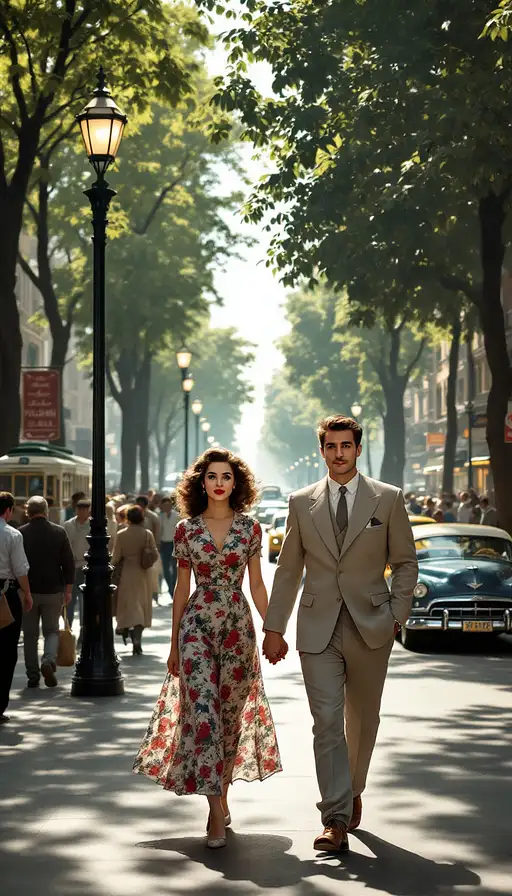
6 months ago
a young couple from the 1950s walking along the vibrant and busy streets of Vali Asr Street (formerly Pahlavi Street) in Tehran. The scene is set in the heart of the city, with the distinct architecture and atmosphere of the time. The girl, with voluminous, curly hair, cat-eye eyeliner, and red lipstick, wears a floral patterned dress with a wide collar and a flared skirt typical of the 1950s. The boy, with neatly styled hair and a thin mustache, wears a light-colored wide-collared suit with a shirt and thin tie. The couple walks hand in hand, surrounded by bustling pedestrians. The wide, tree-lined street is lined with tall, green plane trees, casting dappled shadows on the sidewalk. Vintage streetlamps illuminate the pathway, while classic Persian storefronts, with signs written in traditional fonts, line the street. Old cars from the era drive by, including taxis, and a few trams can be seen passing in the background. The atmosphere is lively, with sounds of city life and the hustle of pedestrians. Sunlight filters through the trees, casting a golden glow over the scene, evoking the warm and nostalgic charm of 1950s Tehran. The iconic tall plane trees frame the scene, and the towering buildings of the time stand proudly in the distance, preserving the historic elegance of the era.

6 months ago
Giant rotating ovens, glowing like fiery caves, slowly roast the nuts to crispy perfection. Tiny chefs, armed with giant spatulas, stir the roasting trays with immense effort, ensuring an even golden crunch. Meanwhile, in another chamber, massive drying tunnels gently remove excess moisture from the fruits, preserving their soft textures and natural sweetness. The air fills with a rich, toasty aroma, swirling through the miniature world.

7 months ago
A highly detailed and hyper-realistic full-body digital illustration of a 18-year-old blonde woman with a beautiful face, a charming smile, and sleek ponytail. She has photorealistic skin texture and expressive eyes, wearing a pink, form-fitting athletic or professional outfit. The character is depicted in multiple dynamic poses: standing confidently with arms crossed, sitting gracefully on a chair, and walking forward with a purposeful stride. Consistent lighting and colors, with a focus on realistic proportions and preserving facial details. The background is a clean white studio setting with soft, even lighting that emphasizes the subject's features and textures. resolution photography interior design, dreamy sunken living room conversation pit, wooden floor, small windows opening onto the garden, bauhaus furniture and decoration, high ceiling, beige blue salmon pastel palette, interior design magazine, cozy atmosphere; 8k, intricate detail, photorealistic, realistic light, wide angle, kinkfolk photography, A+D architecture

8 months ago
"Lord Vishnu, the preserver and protector in Hindu mythology, is depicted as a divine figure of immense beauty and serenity. His form radiates a calming blue hue, symbolizing infinity and cosmic energy. He is adorned with intricate golden jewelry, including a majestic crown encrusted with sparkling gems, necklaces, armlets, and anklets that shimmer with divine brilliance. His four arms hold sacred objects: the Sudarshan Chakra (a spinning disc of cosmic energy), a shankha (conch shell) symbolizing the primordial sound of creation, a gada (mace) representing strength, and a lotus flower symbolizing purity and enlightenment. His attire consists of a silken yellow dhoti, exuding a sense of divine royalty, while his aura glows with a golden radiance.

8 months ago
dynamic, high-speed action, encapsulated in a warm, vibrant sunset backdrop, a tight crop focusing on the airborne skateboard and the soles of shoes, amidst a dance of water droplets, high-resolution photography that captures the brisk movement and subtle details, like water splashing and texture contrasts, Nikon D850 for its fast shutter speeds and high dynamic range, which preserves the rich sunset hues and details in both highlights and shadows, Nikon AF-S NIKKOR 70-200mm f/2.8E FL ED VR, chosen for its sharpness and ability to freeze fast action with a creamy bokeh that isolates the subject, high-speed burst mode, a fast shutter of 1/4000 sec to freeze the droplets, and a low ISO to minimize noise, dynamic underbelly of a skateboard, adorned with gritty street art stickers, and the skater's shoes, mid-flip, black Vans Old school high-top sneakers, laces tied tightly for secure footwork, grip the board's edge, while the grip tape on the board's surface shows wear from many rides. an urban playground, likely a skate park or a rain-slicked street, where reflective puddles mirror the fiery sky, ground glistens with recent rain, and in the background, the silhouettes of city structures stand against the gradient of the sunset, sun's dying light casts everything in a rich amber, with silhouettes sharply defined and water droplets glittering like jewels in the air, every splash and ripple, the texture of the skateboard's underside, the treads of the sneakers, and the distant clouds all sing with clarity, scene is a high-contrast, vibrant end-of-day street scene where nature's beauty meets the raw energy of street sports, all heightened by the dramatic lighting of dusk, UHD, many details --ar 9:16 --style raw --stylize 700
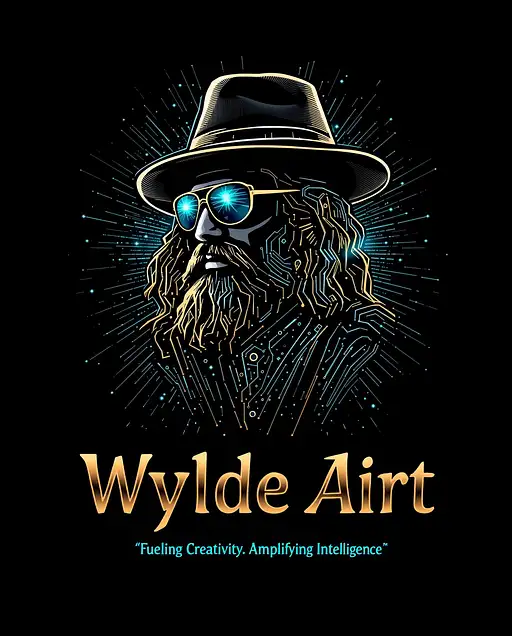
3 months ago
Create a high-impact, retro Steampunk logo for the brand "Wylde Airt", preserving the following visual structure: Central Symbol: Design a stylized, hippie profile, steampunk sunglasses and a battered Fedoro tilted down over his left eye silhouette emerging from a digital vortex or burst of data shards. The figure should be a stylized profile of Leonardo da Vinci but abstract, with tech-inspired detailing such as embedded circuits, etched lines, or subtle neon seams along the limbs and chest — symbolizing the fusion of human creativity and AI power. The data vortex behind or around the figure should appear like fragmented code or holographic layers, evoking dynamic intelligence and innovation. Typography: The brand name must be written exactly as “Wylde Airt” — with capital “W” and “A”, the rest lowercase. Use an elegant, funky retro serif or a groovy funky-luxury hybrid font. Apply a reflective psychedelic metallic finish, with subtle teal or electric blue glows or accents, to convey innovation and digital sophistication. Tagline: “Fueling Creativity. Amplifying Intelligence.” Position directly beneath the brand name in a clean, smaller cursive font. Match the metallic gradient and apply the same color accents to maintain cohesion. Background: Use a dark slate or matte black background with possible faint geometric patterns or circuitry etched into the backdrop to add depth and contrast — making the metallic elements and glow effects stand out. Overall Feel: Premium, bold, and visionary. Avoid generic AI symbols, mascots, or cartoon-like elements. Focus on a sleek, custom, and ownable design language that reflects cutting-edge creativity and power.

6 months ago
A young couple from the 1950s walking along the vibrant and busy streets of Vali Asr Street (formerly Pahlavi Street) in Tehran. The scene is set in the heart of the city, with the distinct architecture and atmosphere of the time. The girl, with voluminous, curly hair, cat-eye eyeliner, and red lipstick, wears a floral patterned dress with a wide collar and a flared skirt typical of the 1950s. The boy, with neatly styled hair and a thin mustache, wears a light-colored wide-collared suit with a shirt and thin tie. The couple walks hand in hand, surrounded by a few pedestrians. The wide, tree-lined street is lined with tall, green plane trees, casting dappled shadows on the sidewalk. Vintage streetlamps illuminate the pathway. The classic Persian storefronts have minimal signage, with some written in traditional fonts. A few old cars from the era drive by, including a taxi, and a tram passes in the background. The atmosphere is lively but not crowded, with the gentle hum of the city and the occasional sound of footsteps. Sunlight filters through the trees, casting a golden glow over the scene, evoking the warm and nostalgic charm of 1950s Tehran. The iconic tall plane trees frame the scene, and the towering buildings of the time stand proudly in the distance, preserving the historic elegance of the era.

8 months ago
dynamic, high-speed action, encapsulated in a warm, vibrant sunset backdrop, a tight crop focusing on the airborne skateboard and the soles of shoes, amidst a dance of water droplets, high-resolution photography that captures the brisk movement and subtle details, like water splashing and texture contrasts, Nikon D850 for its fast shutter speeds and high dynamic range, which preserves the rich sunset hues and details in both highlights and shadows, Nikon AF-S NIKKOR 70-200mm f/2.8E FL ED VR, chosen for its sharpness and ability to freeze fast action with a creamy bokeh that isolates the subject, high-speed burst mode, a fast shutter of 1/4000 sec to freeze the droplets, and a low ISO to minimize noise, dynamic underbelly of a skateboard, adorned with gritty street art stickers, and the skater's shoes, mid-flip, black Vans Old school high-top sneakers, laces tied tightly for secure footwork, grip the board's edge, while the grip tape on the board's surface shows wear from many rides. an urban playground, likely a skate park or a rain-slicked street, where reflective puddles mirror the fiery sky, ground glistens with recent rain, and in the background, the silhouettes of city structures stand against the gradient of the sunset, sun's dying light casts everything in a rich amber, with silhouettes sharply defined and water droplets glittering like jewels in the air, every splash and ripple, the texture of the skateboard's underside, the treads of the sneakers, and the distant clouds all sing with clarity, scene is a high-contrast, vibrant end-of-day street scene where nature's beauty meets the raw energy of street sports, all heightened by the dramatic lighting of dusk, UHD, many details --ar 9:16 --style raw --stylize 700

21 days ago
Isolate the girl and erase the other person. Edit only her outfit by shortening the black patterned dress into a fitted one piece swimsuit. Preserve the original ornate white designs and fabric texture. Do not alter her pose, facial expression, hairstyle, shoes, or any other elements of the scene. add a lightweight top with a deep V-neckline extending to the bust line. The top should be sleeveless or have thin straps, made of a soft, breathable fabric that complements the skirt. Preserve the original bust shape and proportions—do not enhance, reduce, or reshape it. Maintain the ornate white designs and fabric texture across the new neckline. Adjust the entire dress to appear tighter and more form-fitting, as if made from a stretchy lycra-like fabric, while preserving the original bust shape and proportions. Keep her rose gold heels unchanged (including texture, shadows and shining). Her legs should look average, natural, with medium proportions - not skinny, not thick. - Ensure photorealistic detail, consistent indoor lighting, natural shadows and reflections, and seamless integration with the original image.

4 months ago
Make a simple LOGO/Symbol that represents the following information.. History of the Hakka People - Key Points Here's a breakdown of Hakka history in point form, covering their origins, migrations, culture, and modern situation: **I. Origins & Early History (Pre-Song Dynasty - Before 960 AD)** * **Han Chinese Roots:** The Hakka are a subgroup of the Han Chinese, *not* a separate ethnic group. Their name “Hakka” (客家) literally means “guest families.” * **Northern Origins:** Most scholars believe the Hakka originated from areas of North and Central China (Henan, Shanxi, Shaanxi) during periods of upheaval. * **Multiple Migrations:** They weren’t a single migration, but *waves* of migration southward over centuries, starting as early as the Qin and Han dynasties (221 BC – 220 AD). * **Avoiding Conflict:** These migrations were often driven by political instability, war, and famine. The Hakka tended to move *away* from conflict, not to conquer. * **Early Settlers in Jiangxi:** The Jiangxi province became an early and important staging ground for their southern migrations. **II. The Long Migration & Settlement (Song - Ming Dynasties - 960 - 1644 AD)** * **Southern Migration Intensifies:** The Song Dynasty (960-1279) saw a significant acceleration of Hakka migration southwards. * **Conflict with Existing Populations:** As they moved south, the Hakka often settled in marginal lands or areas already inhabited by other groups (including other Han Chinese, and minority groups like the She and Yao). This led to frequent conflicts and clashes. * **“Guest” Status:** They were often seen as outsiders or "guests" by the existing populations, hence the name “Hakka.” They were often denied full integration. * **Settlement in Guangdong, Fujian, Jiangxi:** The Hakka eventually settled primarily in the provinces of Guangdong, Fujian, and Jiangxi, as well as parts of Sichuan, Hunan, and Guangxi. * **Fortified Villages (Weitou):** Due to constant threats and conflict, the Hakka developed a unique architectural style – fortified, circular villages known as *Weitou* (围头). These served as both homes and defensive structures. * **Development of Distinct Culture:** During this period of migration and isolation, the Hakka developed their own distinct language, customs, and traditions. **III. Qing Dynasty & Modern Era (1644 - Present)** * **Qing Dynasty Stability:** The Qing Dynasty (1644-1912) brought a period of relative stability, allowing the Hakka to consolidate their settlements and develop their economy. * **Continued Marginalization:** However, they remained largely marginalized from mainstream Chinese society, often facing discrimination and economic hardship. * **Taiping Rebellion (1850-1864):** A significant number of Hakka joined the Taiping Rebellion, a large-scale uprising against the Qing Dynasty. This further complicated their relationship with the central government. * **Overseas Migration:** In the late 19th and early 20th centuries, many Hakka emigrated overseas, primarily to Southeast Asia (Malaysia, Indonesia, Thailand, Singapore) and other parts of the world. They became successful merchants and entrepreneurs. * **Communist Revolution (1949):** After the Communist Revolution in 1949, the Hakka were initially seen as a potentially rebellious group due to their history of independence and resistance. * **Recognized as a Minority Group:** In the 1990s, the Chinese government officially recognized the Hakka as one of China’s 56 ethnic groups, though they are still considered a subgroup of the Han Chinese. * **Cultural Revival & Tourism:** In recent decades, there has been a growing interest in Hakka culture and heritage, with efforts to preserve their traditions, language, and architecture. Hakka villages are becoming popular tourist destinations. * **Diaspora Connections:** The Hakka diaspora remains strong, with significant communities around the world maintaining connections to their ancestral homeland. **Key Characteristics of Hakka Culture:** * **Language:** Hakka language (Hakka Hua), a Sinitic language distinct from Mandarin and Cantonese. * **Architecture:** Circular fortified villages (Weitou). * **Cuisine:** Unique Hakka cuisine, known for preserved foods, stuffed tofu, and savory flavors. * **Ancestor Veneration:** Strong emphasis on ancestor worship. * **Matrilineal Traditions (in some areas):** Some Hakka communities retain elements of matrilineal inheritance and family structures. * **Emphasis on Education:** Historically, the Hakka placed a high value on education. This list provides a concise overview of Hakka history and culture. It’s a complex and fascinating story of migration, adaptation, and resilience.
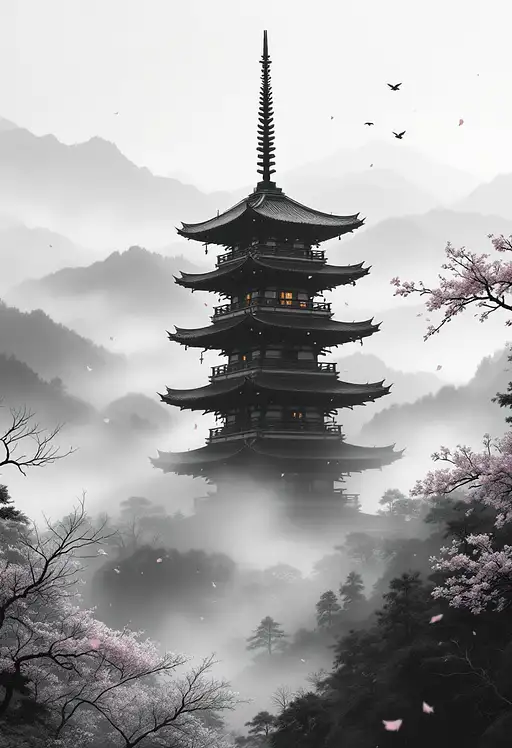
5 months ago
Traditional Japanese pagoda standing tall in a foggy mountain valley, centered mid-range view. leave same same space vertically for the spire to breath. Dense mist surrounds the base and rolls through the distant layered hills. Entire scene rendered in monochrome charcoal tones with no color gradin, Inside the pagoda, include warm interior lighting visible through the windows on just one or two of the middle floors—soft, subtle, and realistic. This lighting should suggest quiet presence and life within, while preserving the tranquil, cinematic mood. Soft pink petals drifting in the air, extremely minimal, serving only as atmospheric accents. Petals should have around 30–40% saturation, subtle but noticeable against the grayscale charcoal background, with mild size variation and slight foreground presence. two bird flying in the distance near the upper right sky with natural variation in size some closer some farther, slight motion and partial mist integration to enhance realism. Bare branches subtly frame the scene on the sides, full cherry blossom trees very soft pink subtle , and no foliage obscuring the pagoda. Moody ink wash aesthetic, inspired by Ghost of Tsushima, cinematic yet understated. High detail in pagoda structure, gentle shadows, calm, and mysterious tone. Minimalist, peaceful composition with deep atmosphere and silence.

5 months ago
Traditional Japanese pagoda standing tall in a foggy mountain valley, centered mid-range view. leave same same space vertically for the spire to breath. Dense mist surrounds the base and rolls through the distant layered hills. Entire scene rendered in monochrome charcoal tones with no color gradin, Inside the pagoda, include warm interior lighting visible through the windows on just one or two of the middle floors—soft, subtle, and realistic. This lighting should suggest quiet presence and life within, while preserving the tranquil, cinematic mood. Soft pink petals drifting in the air, extremely minimal, serving only as atmospheric accents. Petals should have around 30–40% saturation, subtle but noticeable against the grayscale charcoal background, with mild size variation and slight foreground presence. two bird flying in the distance near the upper right sky with natural variation in size some closer some farther, slight motion and partial mist integration to enhance realism. Bare branches subtly frame the scene on the sides, full cherry blossom trees very soft pink subtle , and no foliage obscuring the pagoda. Moody ink wash aesthetic, inspired by Ghost of Tsushima, cinematic yet understated. High detail in pagoda structure, gentle shadows, calm, and mysterious tone. Minimalist, peaceful composition with deep atmosphere and silence.
